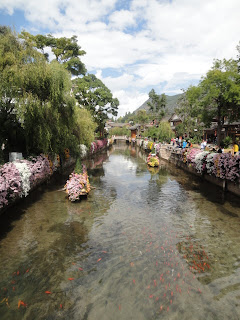We take a plane trip to the south west of China, to Yunnan province. Yunnan is south of Tibet and also borders Vietnam, Laos and Myanmar (Burma). Almost half of the population of this area is made up of 28 recognised ethnic groups. The southern Silk Road between Tibet and India goes through this region, so there are many Tibetans in this area due to the trade of horses from Tibet for tea from India.
The town of Shangri-la is located in Yunnan province, but this is a town recently rebuilt in the style of a Tibetan town and renamed after the book ‘Lost Horizons’, in an attempt to boost tourism. This is a strange inversion of the usual development in China. The norm is that old-style communities are pulled down to put up modern high-rise blocks, but in this place the opposite has happened and the old communist-era buildings have been pulled down and a ‘new’ town built in the old Tibetan style.
Our destination is Lijiang, which is home to the Naxi (pronounced Nashi) tribe, who are descended from a race of Tibetan nomads. They have the only hieroglyphic/pictogram writing system still in use. The Naxi is a matriarchal society with inheritance passing through the female line to the eldest daughter.
Naxi women in traditional dress
Naxi pictogram script on a yak meat shop sign (with English and Chinese too)
Lijiang was badly destroyed by an earthquake in 1996 and the old town was then recreated to be something of a Naxi cultural theme park, so as to recoup the rebuilding cost via tourism. Staying in the old town incurs an entrance fee of 80 Yuan (about £8). The narrow cobbled streets are full of souvenir shops and restaurants, which attracts enormous numbers of Chinese tourists. In spite of such obvious ploys we are glad to be here, as there are no high rise buildings in sight and the old town is traffic-free.
Our luggage is loaded into two tricycles and pedalled by porters into the old town to our guest house. We follow behind on foot through the cobbled streets, which are quiet in the early morning.
luggage transport via tricycle
porter
old town street in the early morning
Our hotel is genuinely old and built in the traditional style around a pleasant courtyard. We will be staying here for 2 nights.
Sunshine Guest House
We take a wander around the old town, by which time the shops are open and things are beginning to get busy. The town is beautifully presented, with a small river running through it and wonderful displays of flowers. There seem to be about 5 different types of shops, all selling Naxi goods; there are ones selling silver jewellery; hand-woven scarves; yak meat; music and percussion instruments; leather goods.These are endlessly repeated along the winding streets which has the effect of making you think you have been here before and losing your sense of direction. The same Chinese folk song playing in many of the shops adds to the effect.
the old town
In the main square Naxi men dressed in their traditional clothes wait with horses to take tourists for a ride and others have hawks that tourist pay to have their photo taken with. The Naxi people are darker skinned than the Han Chinese and they look very reminiscent of the native American Indians.
hawk man and tourists
The town also has many restaurants, catering for the tastes of all tourists, from traditional Naxi, to Chinese, to western and every other style you can think of. Here is one restaurant that was barbecuing half a pig outside, with a goat hanging on a hook nearby.
goat restaurant
We take a walk a short way out of the old town to a nearby lake and park, called Black Dragon Pool. The lake is sacred to the Naxi people and isbeautiful against a backdrop of high ground. Today the clouds are obscuring the main mountain, Jade Mountain, whose snow-capped peak would be visible from here on a clear day.
the lake- on a clear day Jade Mountain would be visible to the left of the high ground
Crowds of tourists gather here to have their picture taken against the backdrop of the lake and mountain.
crowd of tourists looking for the mountain
The fact that the mountain is not visible today is not a problem – there is a small booth here where they will use photo shop to put the mountain into your picture!
adding the mountain to your picture with photoshop
We walk around the perimeter of the lake and before long we are away from the tourist throng. It is peaceful and very beautiful.
the lake and surrounding park
We also enjoy the various signs translated into English. There is one that tells us that ‘The grass is napping; please step quietly’ and this one about keeping the park tidy, ‘Do not disorder rubbish here’.
rubbish sign
In the evening the town becomes even more crowded as people wander the streets browsing the shops and looking for restaurants and bars. The bars put on cabaret-style shows of Naxi singing and dancing and the groups of tourists eating and drinking there, bang the tables with small wooden blocks provided for them, to show their appreciation of the acts.
cabaret act
crowded street at night
Naxi waitresses in the rain

























2 comments:
wow it's so beautiful, i'm loving all the pagodas
wow it's so beautiful, i'm loving all the pagodas
Post a Comment